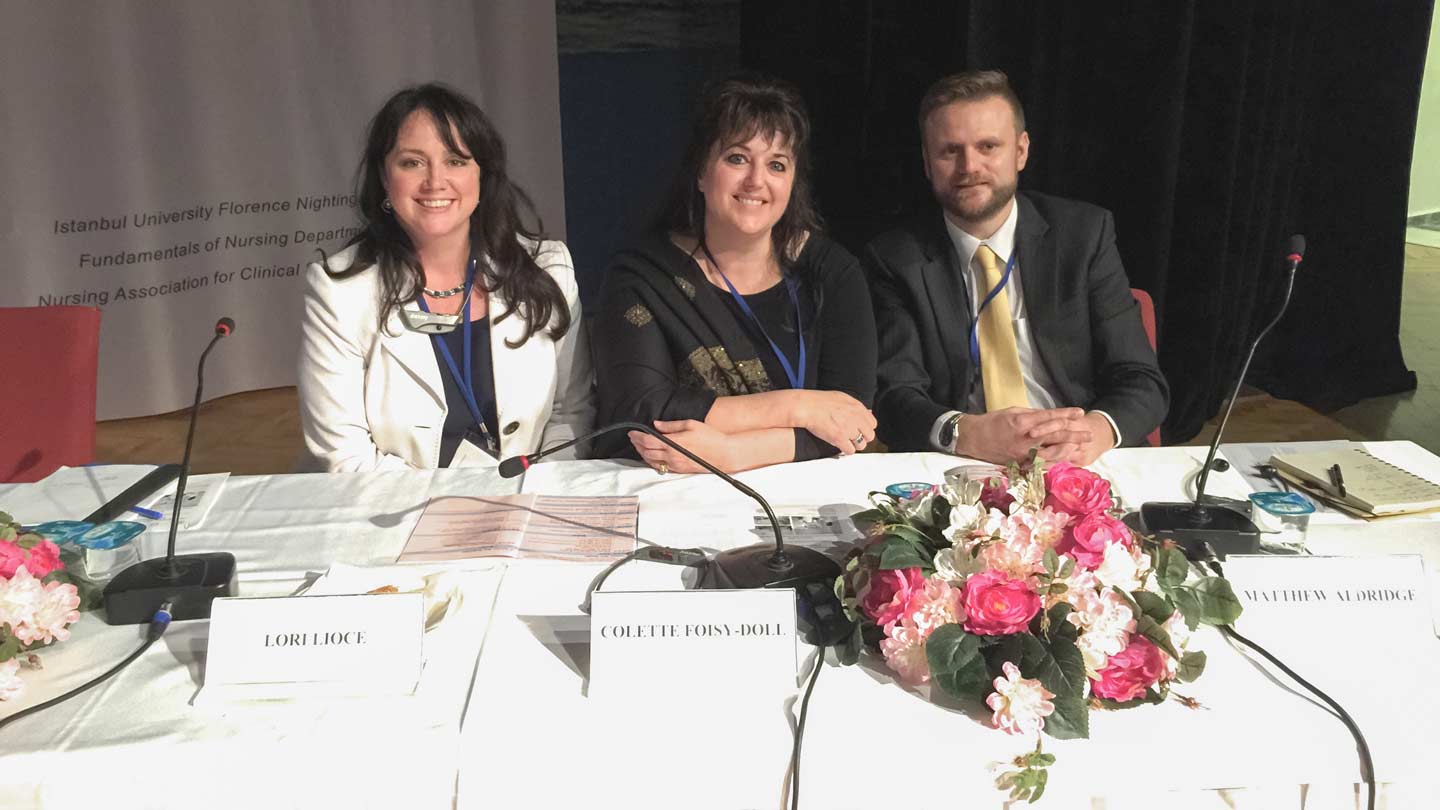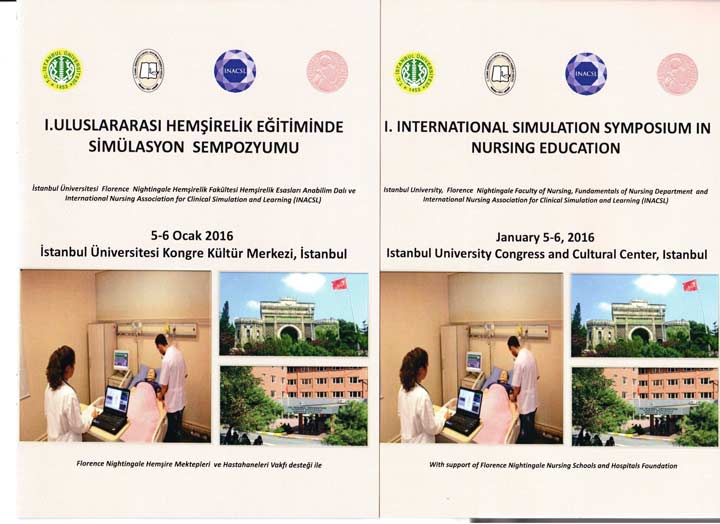
Organizer and UAH nursing professor Dr. Lori Lioce, along with colleagues Ms. Colette Foisy-Doll and Mr. Matthew Aldridge, hosted several expert panel discussions at the first annual International Simulation Symposium in Nursing Education in Istanbul, Turkey, this past January.
Dr. Lori Lioce has long advocated for the increased use of clinical simulation in nursing education. "Technology has advanced so quickly. We are able to make patient simulators that are so humanlike now that we can use them for formative summative and even high-stakes assessment to validate competencies in clinical education for our students," says Dr. Lioce, a clinical associate professor of nursing at The University of Alabama in Huntsville (UAH). "And with simulation education, students are immersed in a situation, which affords us the ability to examine their critical thinking skills and explore the reasoning behind their actions."
In 2011, she says, "we developed a program framework to implement simulations to assist faculty in measuring learning outcomes at UAH." That program has since become an integral component of the College of Nursing's clinical curriculum , with Dr. Lioce now serving as the executive director of the university's brand-new 10,615-square-foot Learning and Technology Resource Center (LTRC), in addition to being the vice president of operations and the past chair of the standards committee for the International Nursing Association for Clinical Simulation and Learning.
We’re not training technicians who watch monitors. We’re training nurses who can assess, clinically reason, communicate, take care of the whole patient, and improve patient safety.
"When I started really getting into simulation, we had one manikin," she says. By contrast, the LTRC houses a 16-bed hospital lab, a 16-table assessment room, four Advanced Practice provider clinical examination rooms, five high-fidelity simulation laboratories, six high fidelity manikins, an obstetric/pediatric four-bed laboratory, an IV practice room, a Pyxis® medication room, a home-health simulation room, and four debriefing rooms. "These advances are due to the long-term support of the College of Nursing's administrative leadership team, university administration, and the faculty, staff, and students," says Dr. Lioce, "with the recent exponential growth in the program under the leadership of our provost, Dr. Christine Curtis, and dean, Dr. Marsha Howell Adams."
It's a huge advantage to UAH - and one that couldn't have been more perfectly timed to the university's recent spike in enrollment. "There are many limitations in higher education to provide clinical practice experiences and much competition for clinical spots in the local hospitals," explains Dr. Lioce. "National studies have shown that you can replace regular clinical experience with up to 50 percent simulation education with the same or better outcomes if there is a standardized framework, trained faculty and staff utilizing best practices. You can engage more students in collaborative learning with simulation."
Now she's taking that winning formula on the road, with the goal of helping other universities with a rapidly growing student body improve their outcomes through simulation education. "I was a panelist in the plenary session at the international meeting in Atlanta last year," says Dr. Lioce, referring to the International Nursing Association for Clinical Simulation and Learning's (INACSL) 2015 conference. "Through the presentation and my international service, I was selected to organize the first annual International Simulation Symposium in Nursing Education in Istanbul, Turkey, this past January."
Presented in partnership with the Florence Nightingale School of Nursing at Istanbul University and INACSL, the conference was held at the university's Congress and Cultural Center. The two-day conference focused on the best practices of simulation education in nursing and how to more fully integrate simulation education into the nursing curriculum. Topics included Simulation Integration: Clinical Objective Mapping; the Essentials of Simulation Scenario Design; and Simulation Standards of Best Practice, among others.

The first annual International Simulation Symposium in Nursing Education was held at the Florence Nightingale School of Nursing at Istanbul University from Jan. 5 to 6, 2016. Download the full PDF here.
"It was a call to action for them," says Dr. Lioce. "They see that they've got everything they need to do be successful; it's just a matter of implementing the delivery differently. They use their manikins for skill demonstrations with group participation in the simulation laboratories and some classrooms. Learning is no longer about teaching on a stage. It's about re-creating an on-demand, immersive, learner-centered environment, where instructors are facilitators and debriefers in clinical situations as opposed to lecturers or one-way communicators. It is about inspiring learners to explore, engage, communicate, and reflect to provide megacognition and decrease/prevent clinical errors."
In total, Dr. Lioce ended up presenting six times over the course of the conference, including hosting several expert panel discussions with her colleagues Ms. Colette Foisy-Doll, a professional resource faculty in the Clinical Simulation Centre at MacEwan University in Alberta, Canada; and Mr. Matthew Aldridge, a senior lecturer with the Faculty of Health and Wellbeing at the University of Wolverhampton in England. The result was a four-country collaboration and a degree of success that all but ensures follow-up conference in 2017. "It will be in the same location, but instead of presentations next year, we'd like to have small working groups and do some immersive hands-on training," she says.
In the meantime, a number of the 400 physicians, administrators, nurses, and faculty members who attended the conference are looking to get their own hands-on experience at UAH long before then. "One of the items I took away was that they have a real hunger for knowledge and application," says Dr. Lioce. "I had about 12 participants ask me about post-doctoral fellowships and the possibility of coming to work alongside us in the LTRC."
Should even just a handful be accepted, her schedule - including upcoming trips to the University of Kentucky, the University of Texas Health Science Center, and the American Association of Nurse Practitioners Annual Conference to talk about simulation education - will no doubt increase. But the investment will be more than worth it, she says, if the end result is the widespread adoption and use of simulation education in nursing across the globe. "We're not training technicians who watch monitors," she explains. "We're training nurses who can assess, clinically reason, communicate, take care of the whole patient, and improve patient safety."
Gallery